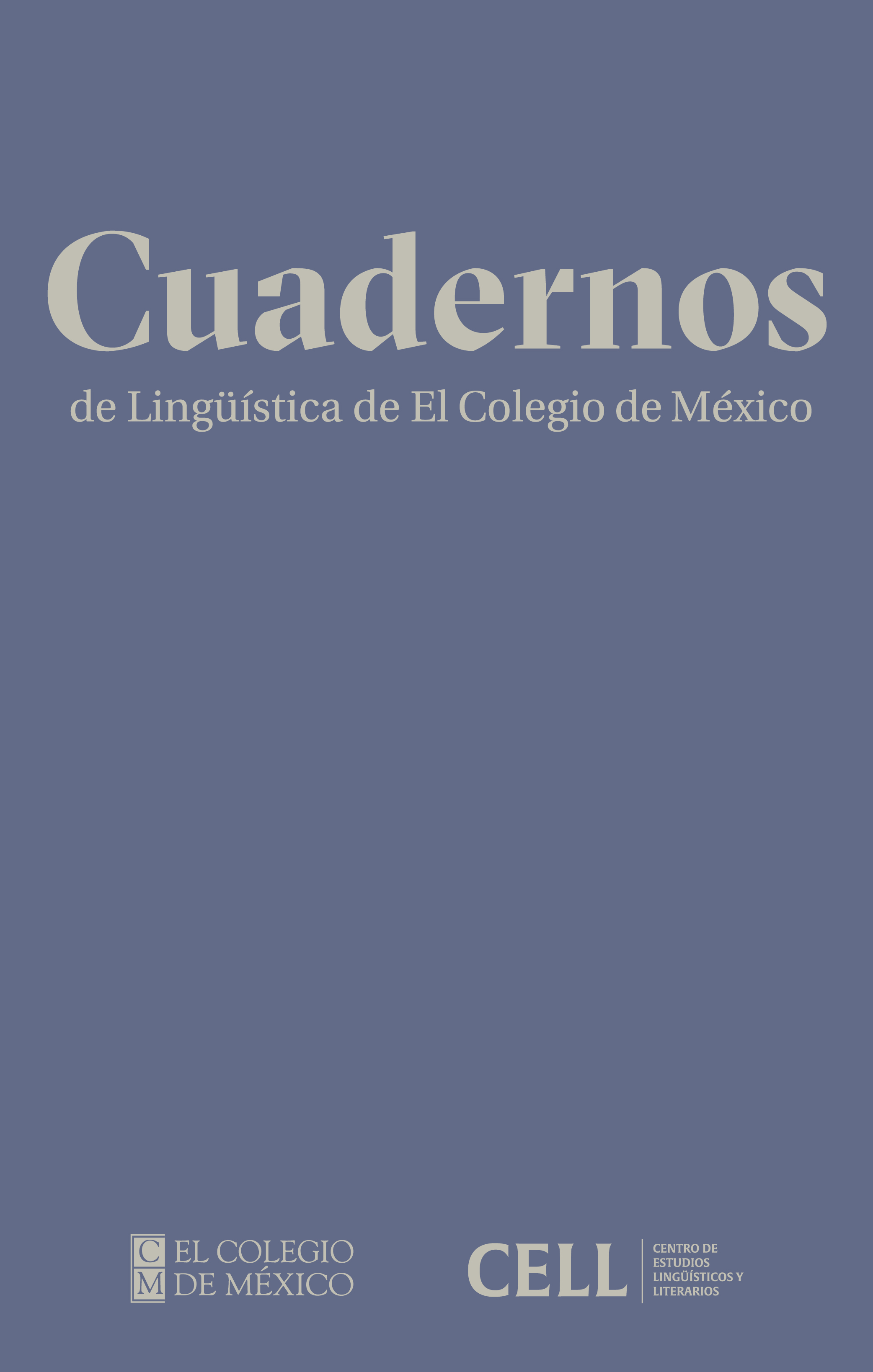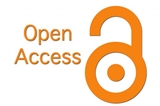The origin of instrumental postpositions in Cahita (Uto-Aztecan): A new account
DOI:
https://doi.org/10.24201/clecm.v10i00.270Keywords:
instrumental and causal postpositions, bridging contexts, possessive noun phrase, non-subject nominalizers, grammaticalizationAbstract
This paper presents a diachronic analysis of instrumental postpositions in Cahita languages (Tehueco, Yaqui and Mayo; Uto-Aztecan). Based on historical data from the beginning of the 17th century (Buelna 1890) and hypotheses about the possible bridging contexts (Heine 2002) that may have favored the grammaticalization processes at the origin of the instrumental morphemes, this study proposes that the origin has to be found in the possessive noun phrase, an origin different from those proposed by Dedrick & Casad (1999) and Haugen (2008). This historical reconstruction also brings to light the connections within the domain of postpositions between instrumental and causal meanings, as well as the connections between postpositions and non-subject nominalizers, since the same marker was used to encode these different functions, exhibiting an interesting polysemy. This paper aims to explain this polyfunctionality from a diachronic perspective, trying to clarify the grammaticalization paths that may have originated such syncretism.
Downloads
References
Álvarez González, Albert. 2012. Relative clauses and nominalizations in Yaqui. In Relative Clauses in Languages of the Americas. A Typological Overview (Typological Studies in Language 102), Comrie, Bernard & Estrada-Fernández, Zarina (eds), 67–96. Amsterdam: John Benjamins. https://doi.org/10.1075/tsl.102.04gon DOI: https://doi.org/10.1075/tsl.102.04gon
Álvarez González, Albert. 2016. The evolution of grammatical nominalizations in Cahita languages. In Chamoreau, Claudine & Estrada-Fernández, Zarina (eds.), Finiteness and nominalization (Typological Studies in Language 113), 107–140. Amsterdam: John Benjamins. https://doi.org/10.1075/tsl.113.06gon DOI: https://doi.org/10.1075/tsl.113.06gon
Álvarez González, Albert. 2018. Apuntes sobre el Manual para administrar a los Indios del idioma Cahita los Santos Sacramentos. In Cifuentes, Bárbara & Martínez Baracs, Rodrigo (eds.), Las lenguas en México: Diálogos historiográficos, 211–232. Mexico: IIB UNAM/Somehil.
Álvarez González, Albert. 2019. The ‘relative’ illusion and the origin of non-subject nominalizers in Cahita (Uto-Aztecan). In Zariquiey, Roberto; Shibatani, Masayoshi & Fleck, David W. (eds.), Nominalization in languages of the Americas (Typological Studies in Language 124), 301-340. Amsterdam: John Benjamins.: https://doi.org/10.1075/tsl.124.07gon DOI: https://doi.org/10.1075/tsl.124.07gon
Álvarez González, Albert & Muchembled, Fany. 2015. Les classificateurs possessifs en langues yuto-aztèques: catégorisations et évolutions. La Linguistique 49(2). 13-34. https://doi.org/10.3917/ling.492.0011 DOI: https://doi.org/10.3917/ling.492.0011
Buelna, Estaquio. 1989[1890]. Arte de la lengua cahita por un padre de la Compañía de Jesús. Mexico: Editorial Siglo XXI.
Campbell, Lyle. 1997. American Indian languages. The historical linguistics of Native America. New York: Oxford University Press. DOI: https://doi.org/10.1093/oso/9780195094275.001.0001
Campbell, Lyle & Langacker, Ronald. 1978. Proto-Aztecan vowels: Parts I-III. International Journal of American Linguistics 44: 85–102, 197–210, 262–279. DOI: https://doi.org/10.1086/465555
Dakin, Karen. 1991. Nahuatl direct and mediated possession: A historical explanation for irregularities. International Journal of American Linguistics 57(3). 298–329. DOI: https://doi.org/10.1086/ijal.57.3.3519722
Dedrick, John M. & Casad, Eugene H. 1999. Sonora Yaqui language structures. Tucson AZ: University of Arizona Press. DOI: https://doi.org/10.2307/j.ctv1jf2crm
Diewald, Gabriele. 2002. A model for relevant types of contexts in grammaticalization. In Wischer, Ilse & Diewald, Gabriele (eds.), New reflections on grammaticalization, 103-120. Amsterdam: John Benjamins. https://doi.org/10.1075/tsl.49.09die DOI: https://doi.org/10.1075/tsl.49.09die
Haugen, Jason D. 2008. Comitative and instrumental postpositions in Uto-Aztecan. In Ortiz Ciscomani, Rosa María (ed.), Memorias del IX Encuentro Internacional de Lingüística en el Noroeste, vol. 2, 191-210. Hermosillo: Universidad de Sonora.
Haugen, Jason D. 2017. Derived verbs of possession in Uto-Aztecan: Reconstructions and paths of change. Anthropological Linguistics 59(2). 163-204. https://doi.org/10.1353/anl.2017.0005 DOI: https://doi.org/10.1353/anl.2017.0005
Heine, Bernd. 2003. Grammaticalization. In Brian D. Joseph & Richard D. Janda (eds), The Handbook of Historical Linguistics, 576–601. Oxford: Blackwell. DOI: https://doi.org/10.1002/9780470756393.ch18
Heine, Bernd. 2002. On the role of context in grammaticalization. In Wischer, Ilse & Diewald, Gabriele (eds.), New reflections on grammaticalization, 83-101. Amsterdam: John Benjamins. https://doi.org/10.1075/tsl.49.08hei DOI: https://doi.org/10.1075/tsl.49.08hei
Heine, Bernd; Claudi, Ulrike & Hünnemeyer, Frederike. 1991a. Grammaticalization. A conceptual approach. Chicago: Chicago University Press.
Heine, Bernd; Claudi, Ulrike & Hünnemeyer, Frederike. 1991b. From cognition to grammar. Evidence from African languages. In Traugott, Elizabeth Closs & Heine, Bernd (eds.), Approaches to grammaticalization, 149-187. Amsterdam: John Benjamins. https://doi.org/10.1075/tsl.19.1.09hei DOI: https://doi.org/10.1075/tsl.19.1.09hei
Heine, Bernd & Kuteva, Tania. 2004. World Lexicon of Grammaticalization. Cambridge: CUP.
Heine, Bernd & Kuteva, Tania. 2007. The Genesis of Grammar: A Reconstruction. Oxford: OUP. DOI: https://doi.org/10.1093/oso/9780199227761.001.0001
Instituto Nacional de Estadística y Geografía/INEGI. 2020. Lenguas indígenas en Méxicoy hablantes (de 3 años y más) al 2020. Retrieved from http://cuentame.inegi.org.mx/hipertexto/todas_lenguas.htm
Langacker, Ronald W. 1977. The syntax of postpositions in Uto-Aztecan. International Journal of American Linguistics 43(1). 11-26. DOI: https://doi.org/10.1086/465451
Lionnet, Andrés. 1978. El idioma tubar y los tubares según documentos inéditos de C. S. Lumholtz y C. V. Hartman. Mexico: Universidad Iberoamericana.
Luraghi, Silvia. 1989. Cause and instruments expressions in Classical Greek. Mnemosyne 42(3/4). 294-307.
Miller, Wick R. 1984. The classification of the Uto-Aztecan languages based on lexical evidence. International Journal of American Linguistics 50(1): 1–24. DOI: https://doi.org/10.1086/465813
Moctezuma, José Luis & López, Gerardo. 1991. El yaqui y el mayo como lenguas históricas. Noroeste de México 10. 79–84.
Narrog, Heiko. 2010. A diachronic dimension in maps of case functions. Linguistic Discovery 8(1). 233-254. https://doi.org/10.1349/PS1.1537-0852.A.352 DOI: https://doi.org/10.1349/PS1.1537-0852.A.352
Palancar, Enrique. 2001. Emergent markers: The relation of instruments, causes, and agents in grammatical constructions. Sprachtypologie und Universalienforschung (STUF) 54(4). 365-384. https://doi.org/10.1524/stuf.2001.54.4.365 DOI: https://doi.org/10.1524/stuf.2001.54.4.365
Peña Valenzuela, Ana Patricia. 2012. Cláusulas relativas en el mayo de Sonora. Hermosillo: University of Sonora. (MA thesis)
Ruvalcaba Garfías, Nancy & Álvarez González, Albert. 2022. Instrumental nominalization in Guarijio. Paper presented in Taller de los amigos de las lenguas yuto-aztecas. October 26th, Colima, Mexico.
Seiler, Walter. 1985. Imonda, a Papuan Language. Canberra: Department of Linguistics Research School of Pacific Studies, Australian National University.
Traugott, Elizabeth C. & Dasher, Richard B. 2005. Regularity in Semantic Change. Cambridge: CUP.
de Wolf, Paul P. 1997. Esbozo del Mayo Sonorense. 2 volumes. Hermosillo: Universidad de Sonora.
Wuellner, Bernard. 2012. Dictionary of Scholastic Philosophy. Fitzwilliam, NH: Loreto Publications.
Published
How to Cite
-
Abstract305
-
PDF183
-
XML13
-
EPUB14
-
Kindle65
-
MP32
Issue
Section
License
Copyright (c) 2023 Albert Álvarez González

This work is licensed under a Creative Commons Attribution-NonCommercial-NoDerivatives 4.0 International License.
Authors retain copyright of their work and are free to disseminate it, make copies for any use, and/or deposit in any repository or archive of their choice, but they grant Cuadernos de Lingüística de El Colegio de México the right to publish the work for the first time. Authors agree to acknowledge Cuadernos de Lingüística de El Colegio de México as the site of original publication of their article / note / review through proper citation.
Articles appearing in Cuadernos de Lingüística de El Colegio de México are made available to readers under a Attribution-NonCommercial-NoDerivatives 4.0 International.









